Measurement of Piston Pin-Bore Oil Film Pressure under Engine Operation
Abstract
1. Introduction
2. EHL Simulation of Piston Pin-Bore Oil Film Pressure
- Nominal oil film thickness
- Local oil film thickness
- Mean hydrodynamic pressure
- Viscosity
- Sliding velocity
- Combined roughness
- Pressure flow factor
- Shear flow factor
- Contact pressure
- Standard devitations of combined roughness
- Peak radius at surface summit
- Surface density of asperity peaks on each surface
- Composite young’s modulus in contact area
- Contact load by shape factor
3. Experimental Equipment and Methodology
3.1. Engine Specifications and Experimental System
3.2. Structure of Thin-Film Pressure Sensors and Fabricated Positions
3.3. Pressure and Temperature Sensitivities
3.4. Lubrication Method between Piston and Pin
4. Experimental Results
4.1. Oil Film Pressure Results Measured with Thin-Film Pressure Sensors
4.2. Correlation between Actual Engine and Unit Fatigue Tester
5. Conclusions
- The oil film pressure at the piston pin-bore interface was measured during engine operation using thin-film pressure sensors fabricated on the sliding surface of the piston pin.
- The durability of the thin-film sensor was improved by using DLC as a protective film, and oil film pressure measurement was achieved up to 3000 rpm and full load.
- Simultaneous measurement of the oil film pressure at each part of the pin boss was performed using a multi-point type thin film sensor, and the pressure change at each measurement position was obtained. Also, the pressure generation state from the start of the engine to the idling of the engine could be measured over time. As a result, we were able to confirm the load sharing state and oil lubrication state of the piston pin boss at each measurement position.
- Immediately after engine startup, oil supply was not sufficient, and locally high pressures of 100 MPa or higher were detected. Especially at the 7 mm position corresponding to the edge of the pin bore, the pressure was over 120 MPa.
- In this study, tests were not conducted under high engine speed and load conditions owing to the nature of the test engine used, but it is planned to conduct tests and evaluations under such conditions in future work.
Author Contributions
Funding
Data Availability Statement
Conflicts of Interest
References
- Ba, L.; He, Z.; Liu, Y.; Zhang, G. Analysis of piston-pin lubrication considering the effects of structure deformation and cavitation. J. Zhejiang Univ. Sci. A 2015, 16, 443–463. [Google Scholar] [CrossRef]
- Knoll, G.; Bargende, M.; Lang, J.; Phili, U. Piston pin in mixed friction contact. MTZ Worldw. 2009, 70, 54–60. [Google Scholar] [CrossRef]
- Mihara, Y.; Hayashi, T.; Nakamura, M.; Someya, T. Study on the Measurement of Oil-film Pressure of Engine Main Bearing by means of New Developed Thin Film Sensor under Engine Operating Conditions. Trans. JSAE 1995, 26, 40–45. (In Japanese) [Google Scholar]
- Inui, M.; Kobayashi, M.; Oowaki, K.; Furukawa, T.; Mihara, Y.; Owashi, Y. Analysis of Oil Film Generation on the Main Journal Bearing Using a Thin-Film Sensor and Elasto-Hydrodynamic Lubrication (EHL) Model. SAE Int. J. Fuels Lubr. 2013, 6, 119–125. [Google Scholar] [CrossRef]
- Mihara, Y.; Someya, T. Measurement of Oil-Film Pressure in Engine Bearings Using a Thin-Film Sensor. Trib. Trans. 2002, 45, 11–20. [Google Scholar] [CrossRef]
- Mihara, Y.; Someya, T. Study on the Measurement of Oil Film Pressure Distribution on Plain Bearings using Thin-film Sensors. J. Jpn. Inst. Mar. Eng. 2007, 42, 595–600. (In Japanese) [Google Scholar] [CrossRef]
- Shibata, M.; Owashi, M.; Mihara, Y.; Tachibana, Y.; Yoshida, H.; Suzuki, T.; Otake, K. Measurement of oil film pressure distribution in piston skirtsusing multi-layer type thin film pressure sensor. In Proceedings of the JSAE Fall Congress (CD-ROM) 2016, Yokohama, Japan, 25–27 May 2016. page ROMBUN No. 2921. (In Japanese). [Google Scholar]
- Kamiya, M.; Kobayashi, T.; Mihara, Y.; Someya, T. Measurement of Piston Skirt Oil-film Pressure under Piston Slap; SAE Technical Paper 2007-01-2215; SAE International: Warrendale, PA, USA, 2007. [Google Scholar] [CrossRef]
- Miura, K.; Owashi, M.; Mihara, Y. High Durability Thin-Film Pressure Sensor Development. In Proceedings of the Ninth International Conference on Modeling and Diagnostics for Advanced Engine Systems (COMODIA 2017), Okayama, Japan, 25–28 July 2017. C314. [Google Scholar]
- Miura, K.; Owashi, M.; Mihara, Y. Thin Film Sensors for Measuring Oil Film Condition in Engine Sliding Surfaces. In Proceedings of the World Tribology Congress 2017, Beijing, China, 17–22 September 2017. [Google Scholar]
- Mihara, Y.; Matsuzaki, T.; Someya, T. Measurement of piston pin-boss oil-film pressure in engine operating condition using a thin-film sensor. Trans. JSAE 2007, 39, 125–130. (In Japanese) [Google Scholar]
- Mihara, Y.; Yamada, D.; Someya, T.; Goto, T. Study on Measurement of Oil Film Pressure on Piston Pin Boss using Thin-film Sensors. Trans. JSME 1998, 98, 561–562. (In Japanese) [Google Scholar]
- Miura, K.; Kobayashi, K.; Yamakawa, N.; Saruwatari, M.; Mihara, Y. Measurement of Oil Film Pressure in Piston Pin-Boss by Thin-Film Pressure Sensor; SAE Technical Paper 2015-01-204; SAE International: Warrendale, PA, USA, 2015. [Google Scholar] [CrossRef]
- Kano, M. Diamond-Like Carbon Coating Applied to Automotive Engine Components. Tribol. Online 2014, 9, 135–142. [Google Scholar] [CrossRef]
- Iwata, T.; Oikawa, M.; Chida, R.; Ishii, D.; Ogihara, H.; Mihara, Y.; Kano, M. Excellent Seizure and Friction Properties Achieved with a Combination of an a-C:H:Si DLC-Coated Journal and an Aluminum Alloy Plain Bearing. Coatings 2021, 11, 1055. [Google Scholar] [CrossRef]
- Higuchi, T.; Mabuchi, Y.; Ichikawa, H.; Murata, T.; Moronuki, M. Development of Hydrogen-Free Diamond-Like Carbon Coating for Piston Rings. Tribol. Online 2017, 12, 117–122. [Google Scholar] [CrossRef][Green Version]
- Toyoda, S. All Toyota Tribological Innovation to Realize “Zeronize” and “Maximize” Society. Tribol. Online 2007, 2, 19–22. [Google Scholar] [CrossRef][Green Version]
- Treutler, C.P.O. Industrial use of plasma-deposited coatings for components of automotive fuel injection systems. Surf. Coat. Technol. 2005, 200, 1969–1975. [Google Scholar] [CrossRef]
- Patir, N.; Cheng, H.S. An Average Flow Model for Determining Effects of Three-Dimensional Roughness on Partial Hydrodynamic Lubrication. ASME J. Lubr. Tech. 1978, 100, 12–17. [Google Scholar] [CrossRef]
- Patir, N.; Cheng, H.S. Application of Average Flow Model to Lubrication Between Rough Sliding Surfaces. ASME J. Lubr. Tech. 1979, 101, 220–229. [Google Scholar] [CrossRef]
- Greenwood, J.A.; Tripp, J.H. The Contact of Two Nominally Flat Rough Surfaces. Proc. Inst. Mech. Eng. 1970, 185, 625–633. [Google Scholar] [CrossRef]
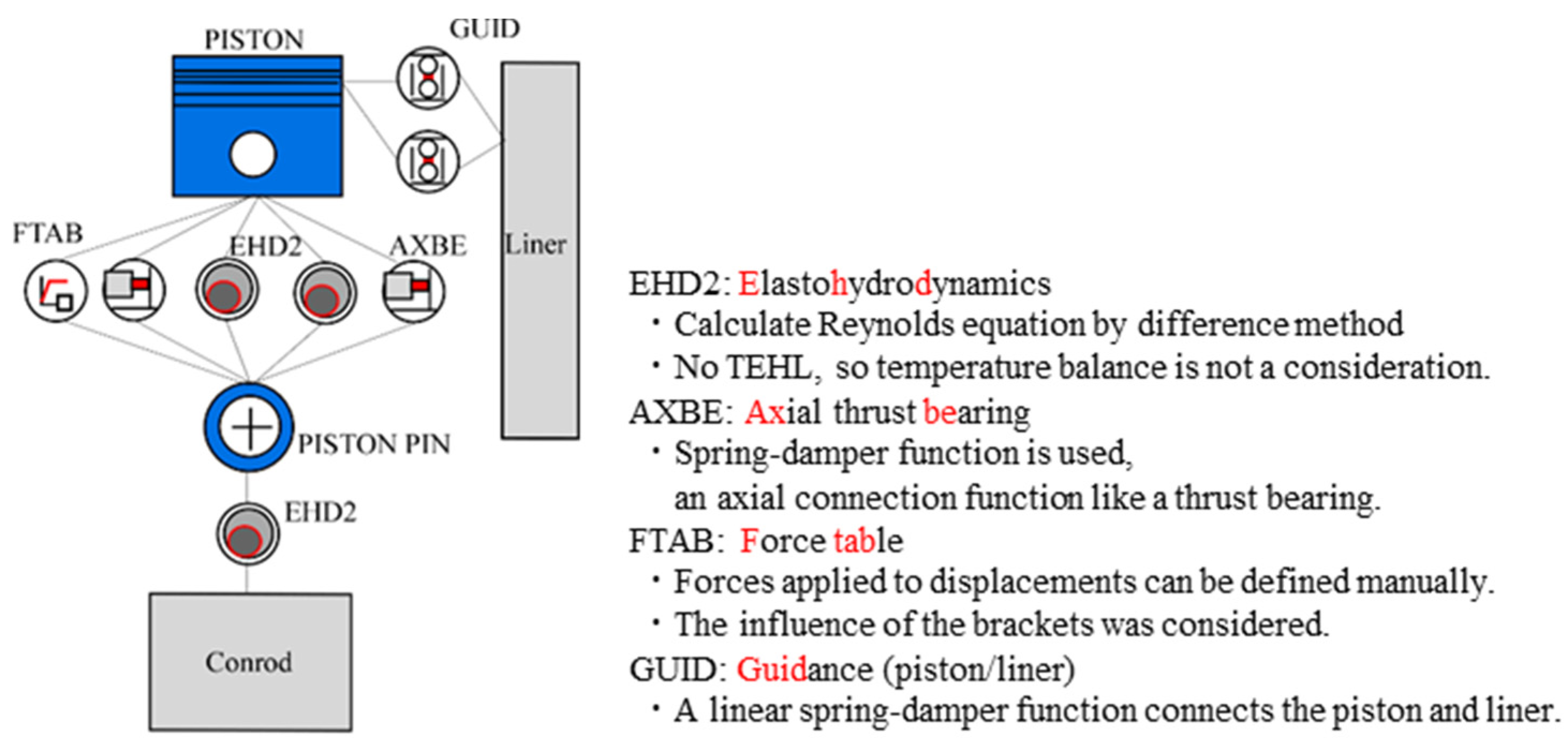
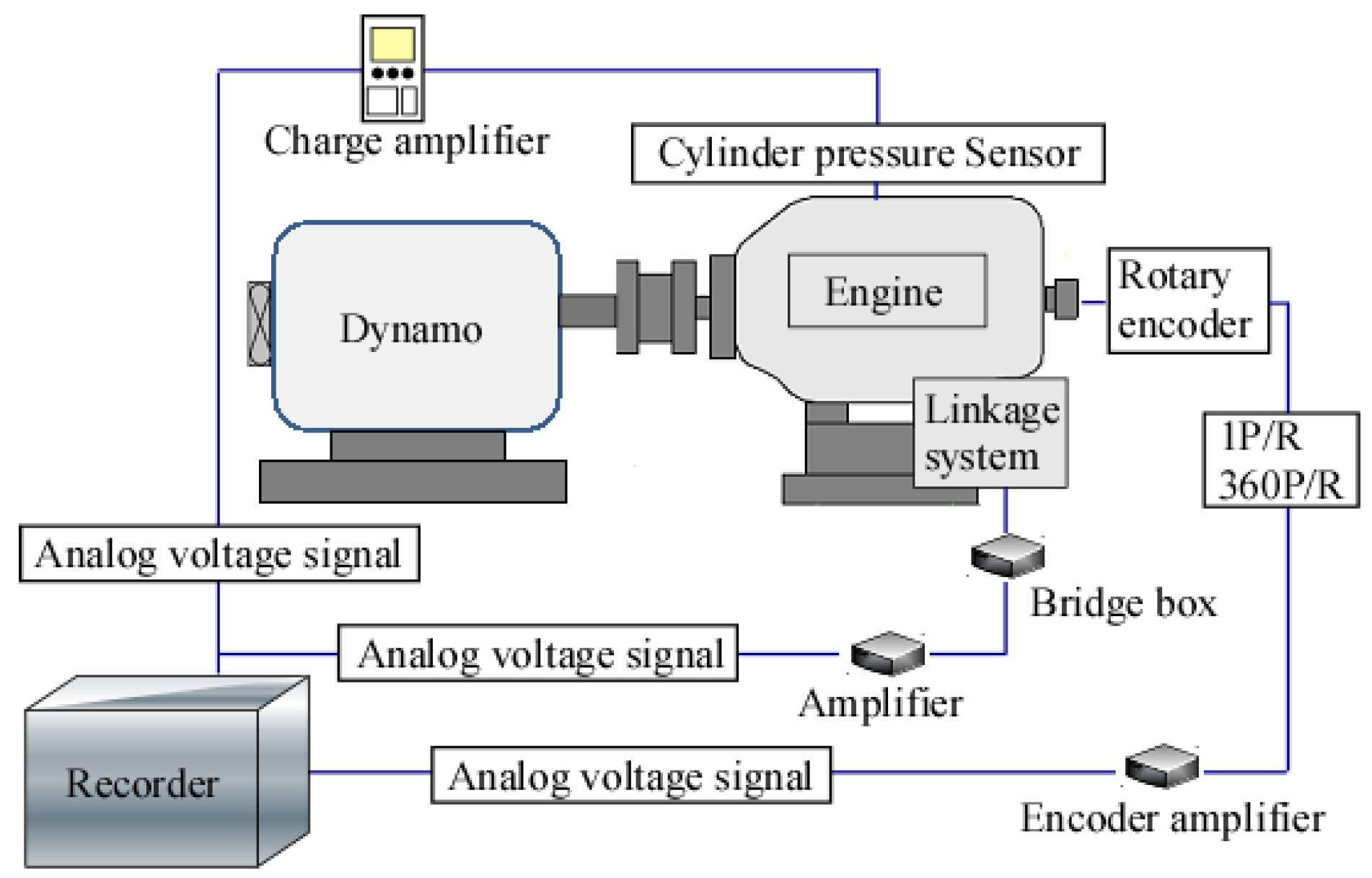
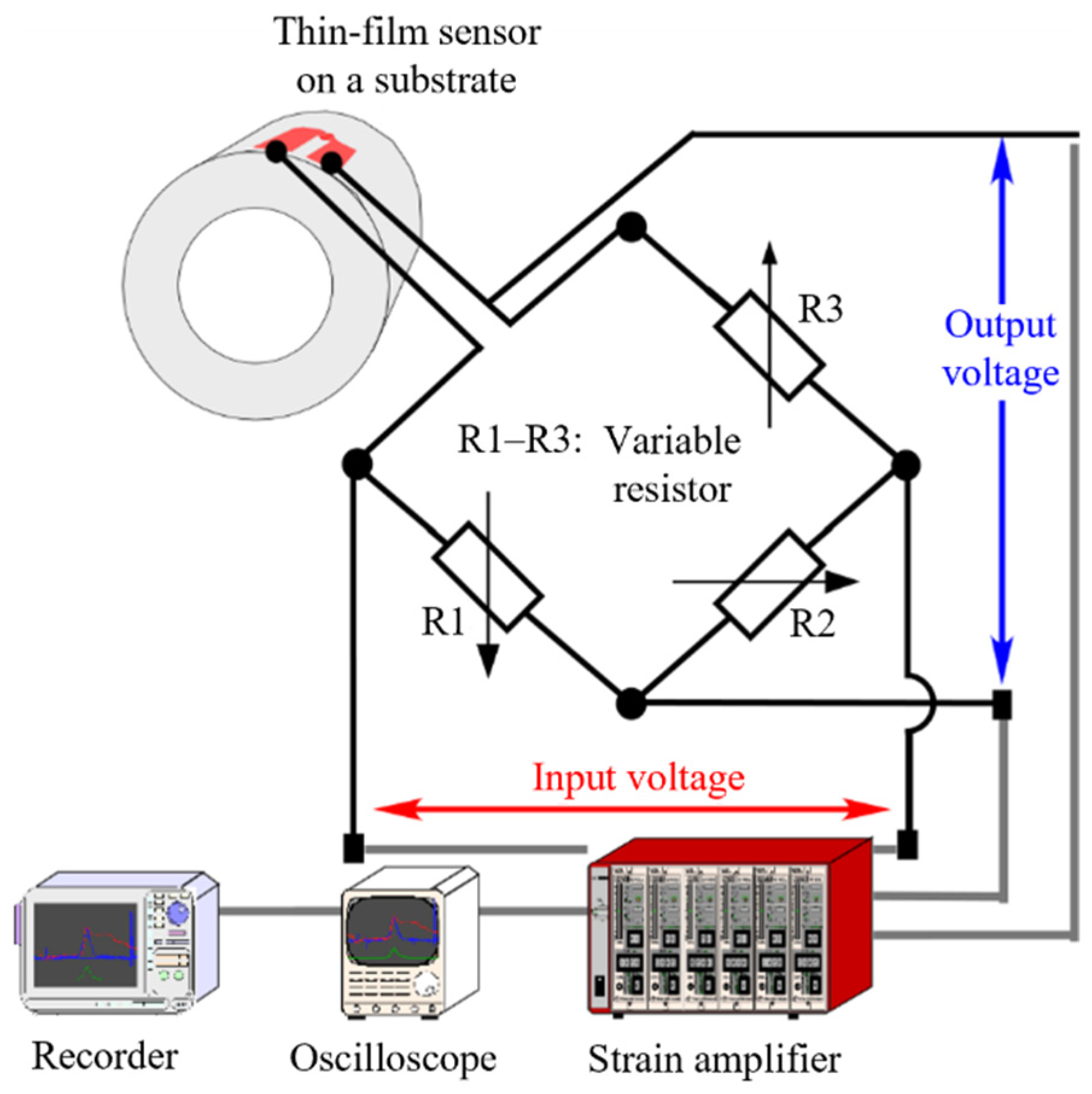

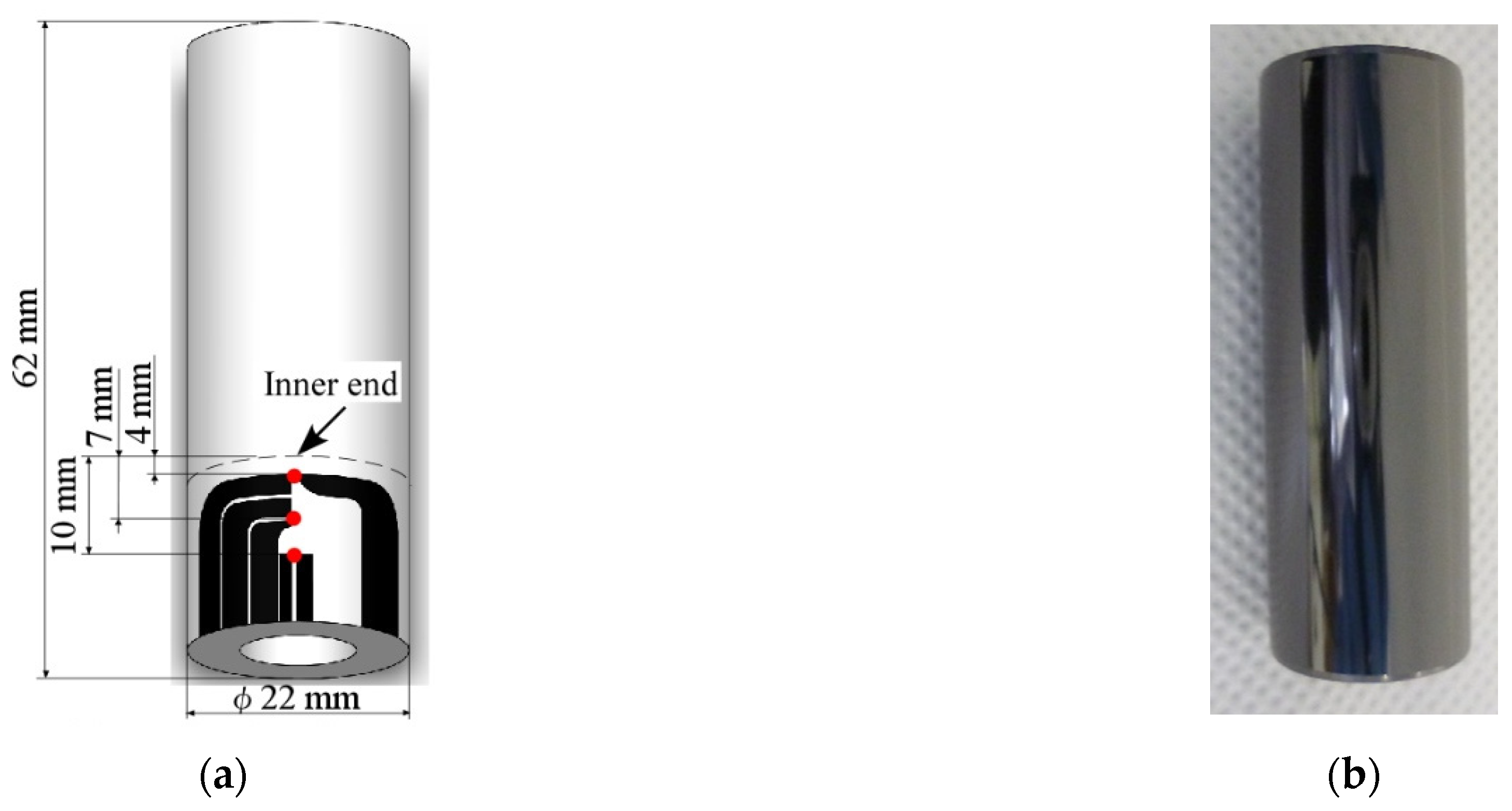
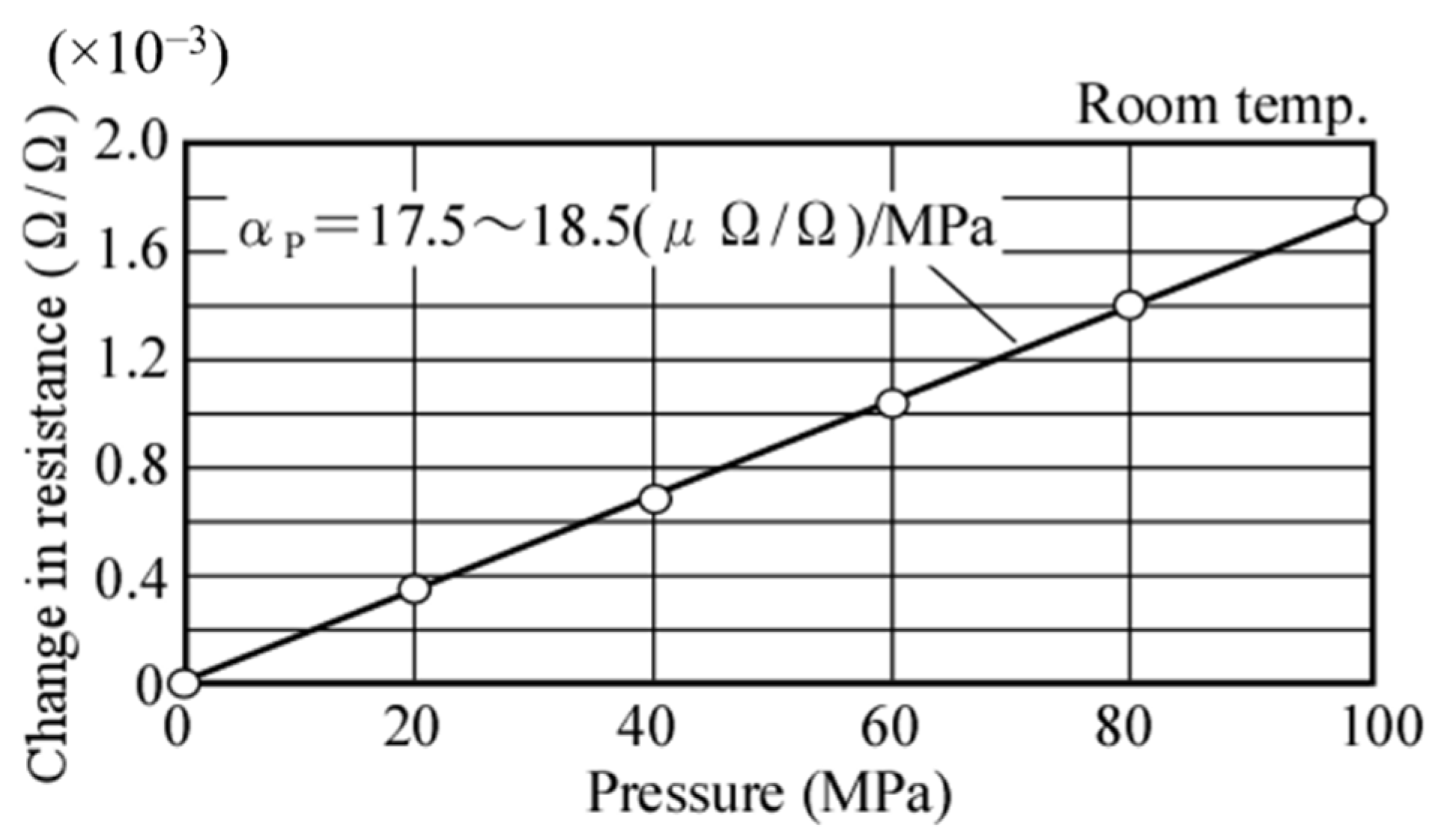
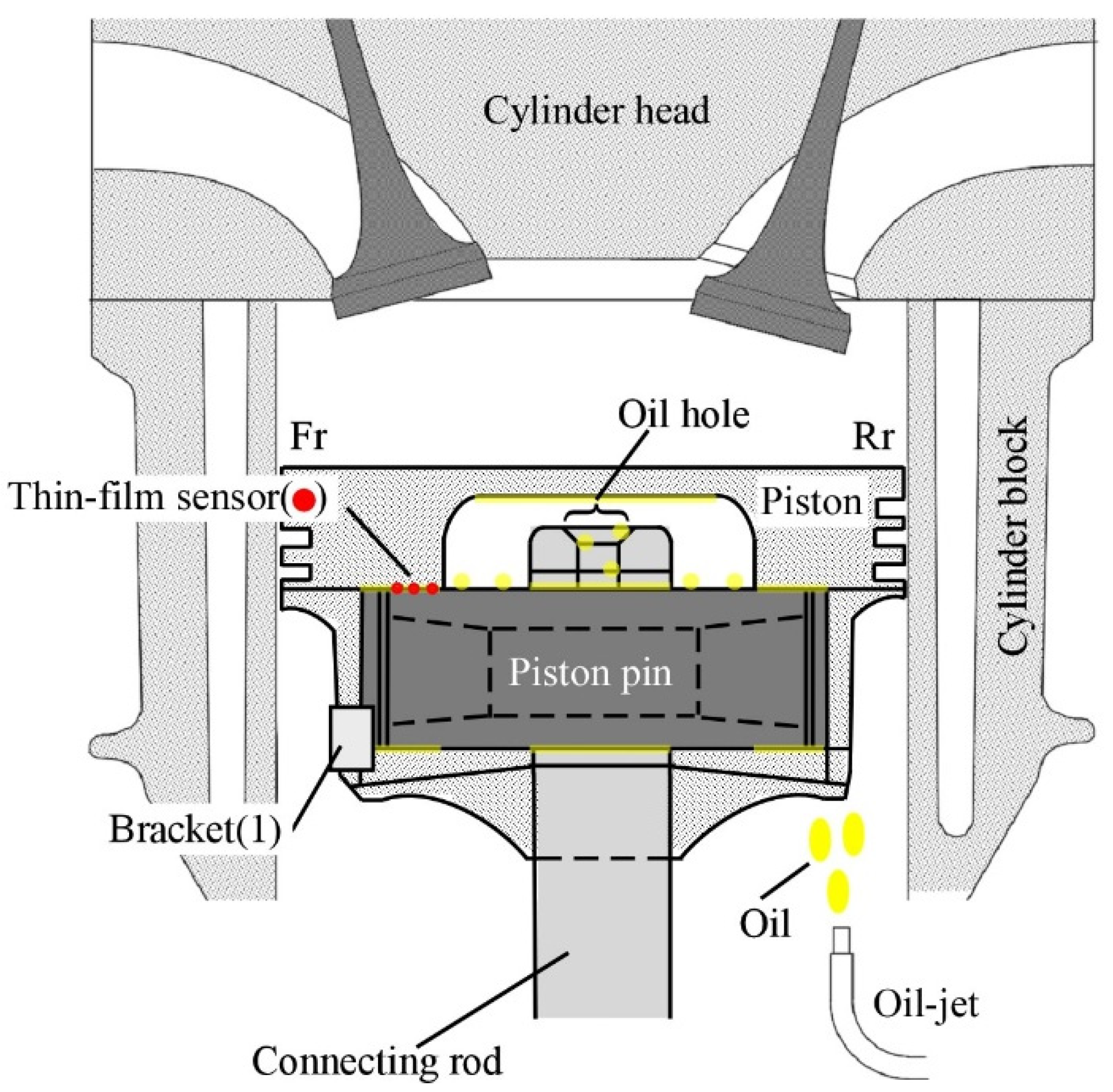

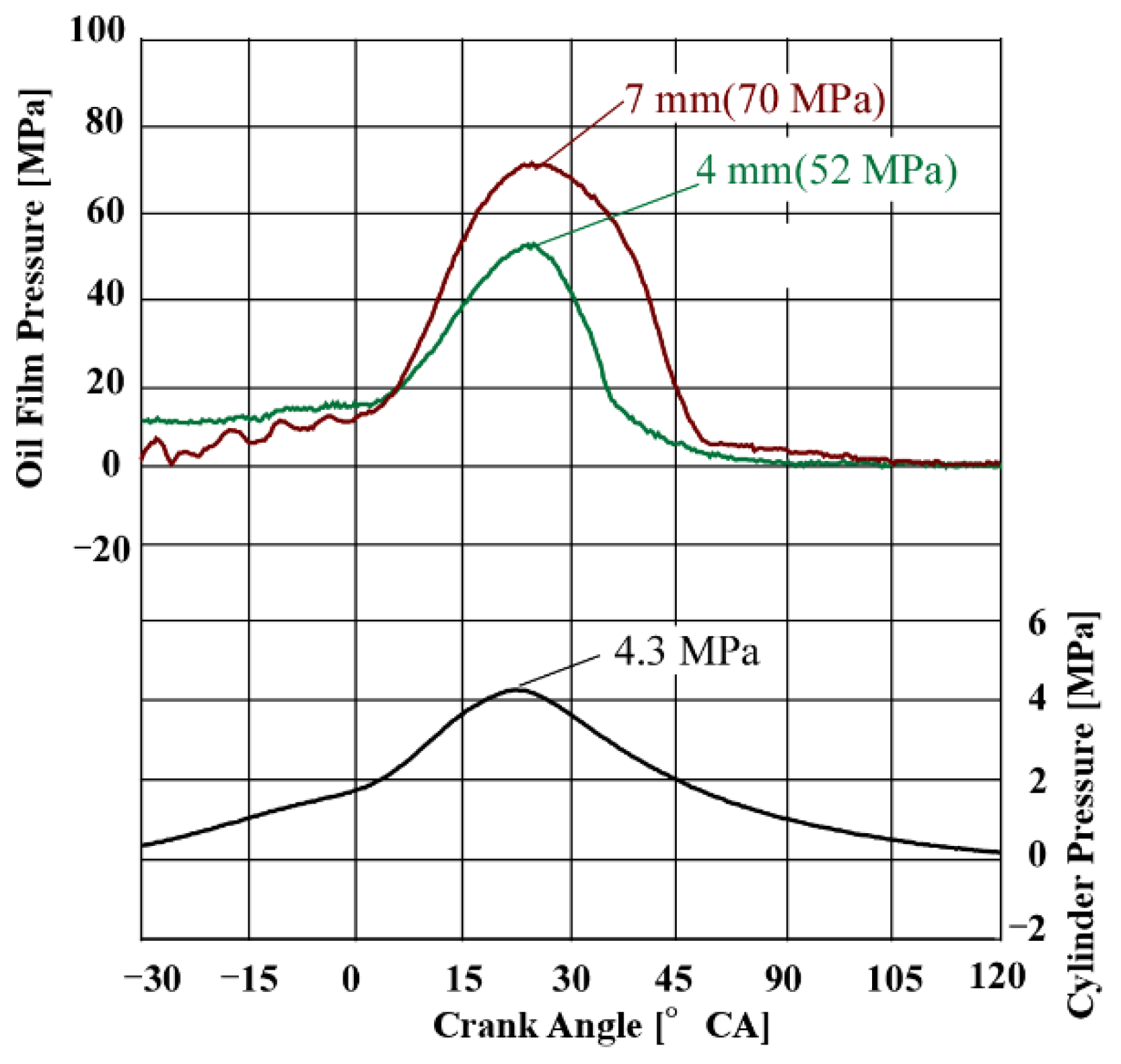
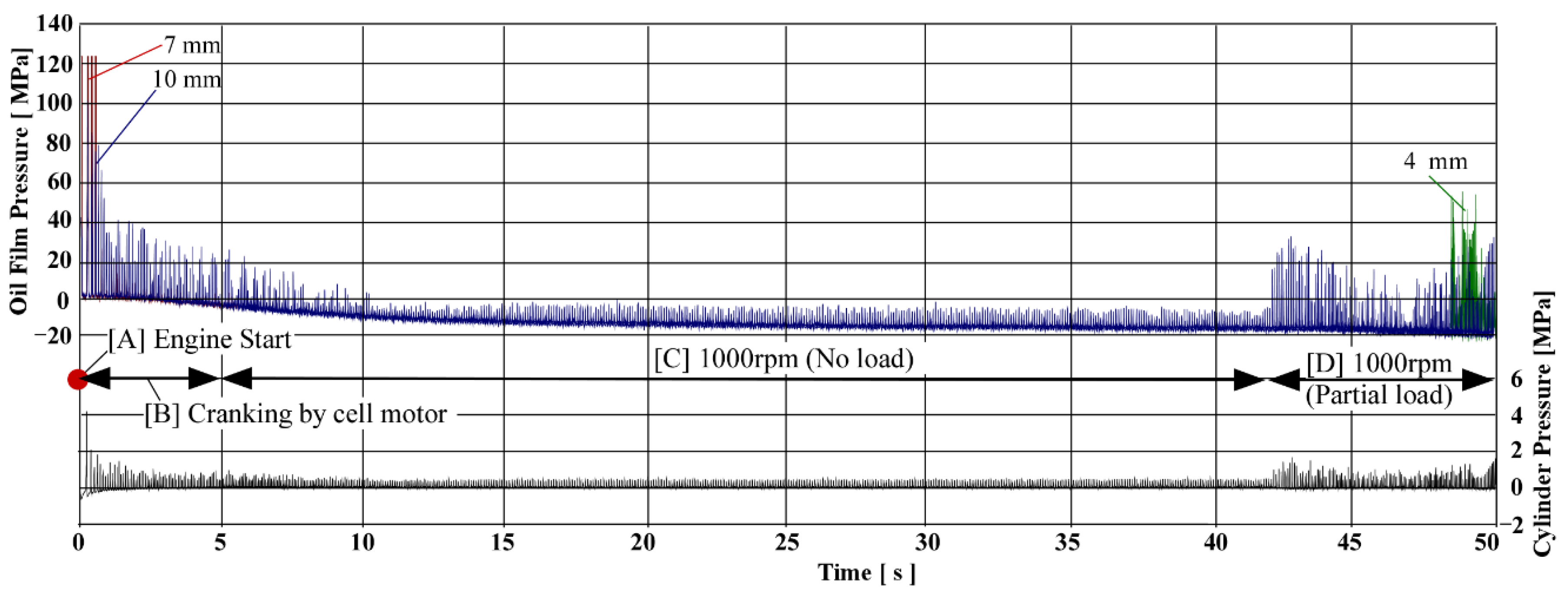

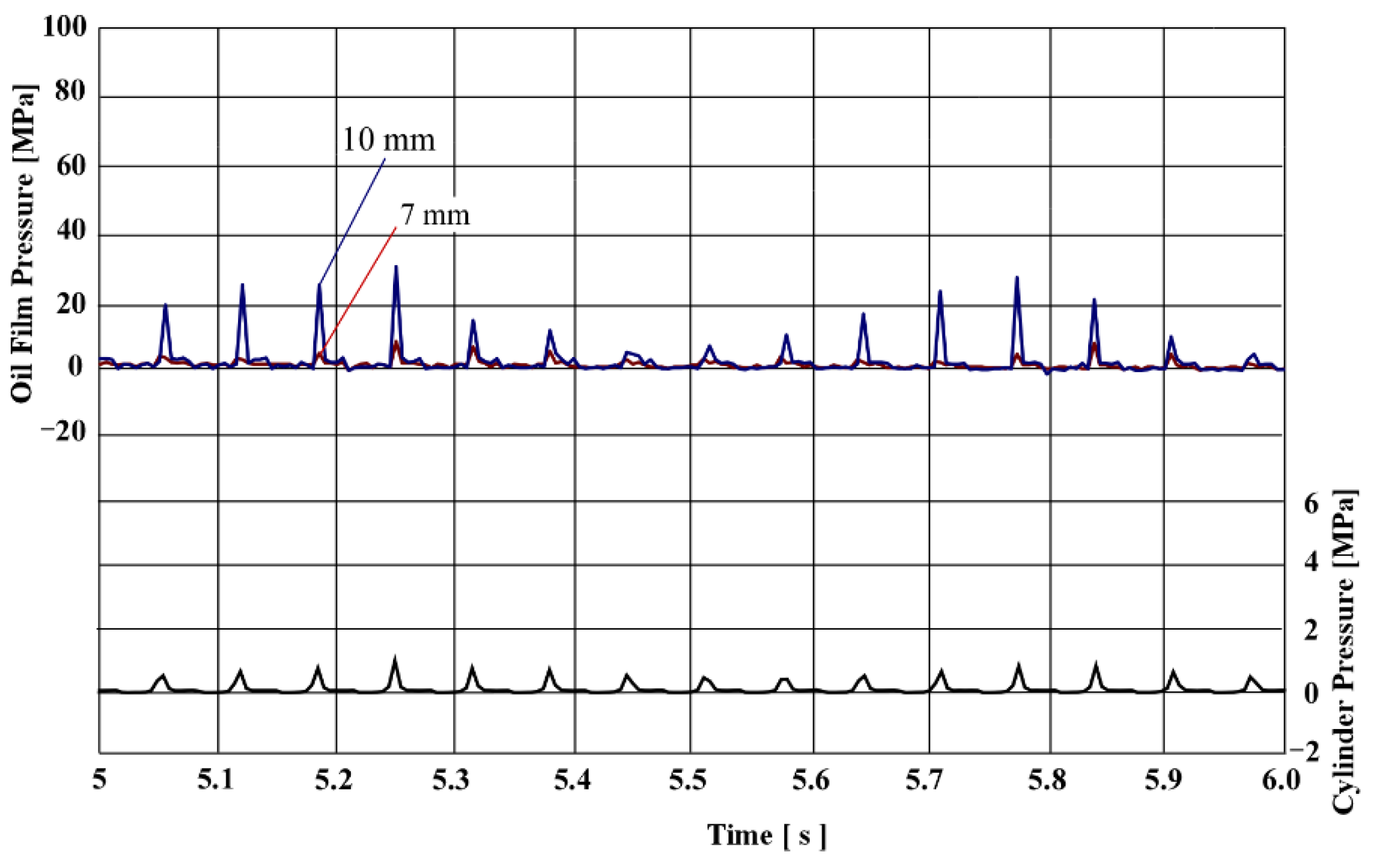

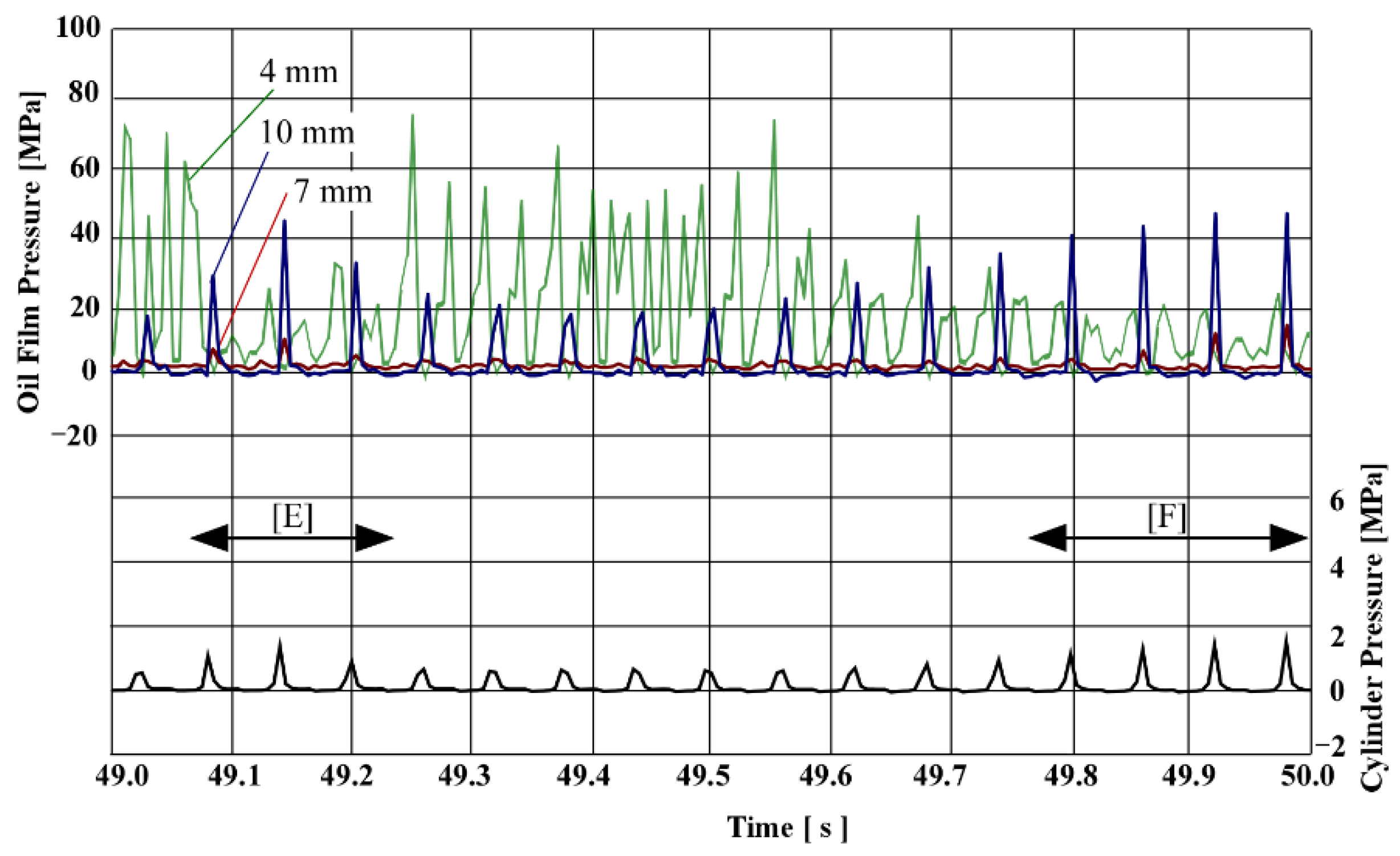
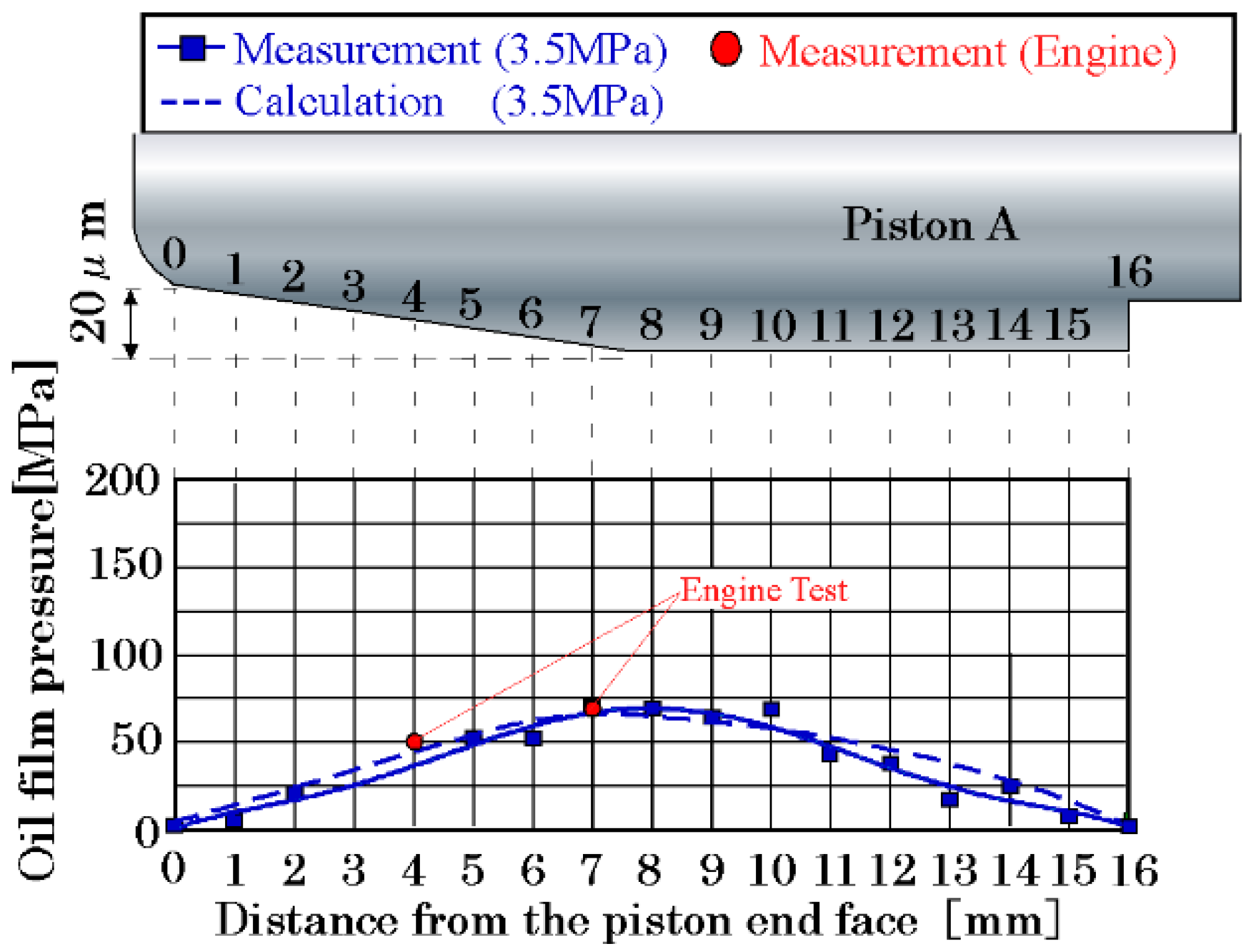
| Item | Specification |
|---|---|
| Engine type | In-line 4-cylinder gasoline engine |
| Bore × Stroke (mm) | 90 × 98 |
| Displacement (cm3) | 2494 |
| Compression ratio | 10.4 |
| Engine Speed (rpm) | Load (Nm) | Oil Temp. (°C) | Water Temp. (°C) | Piston Pin Temp. (°C) |
|---|---|---|---|---|
| Engine start to 1000 rpm | No load | 32.0 | 40.4 | 50.5–52.1 |
| 2000 | Partial load | 86.1 | 57.3 | 111.4 |
| 3000 | Full load | 107.0 | 78.8 | 141.7 |
Publisher’s Note: MDPI stays neutral with regard to jurisdictional claims in published maps and institutional affiliations. |
© 2022 by the authors. Licensee MDPI, Basel, Switzerland. This article is an open access article distributed under the terms and conditions of the Creative Commons Attribution (CC BY) license (https://creativecommons.org/licenses/by/4.0/).
Share and Cite
Iwata, T.; Owashi, M.; Oikawa, M.; Mihara, Y.; Kobayashi, K.; Yamakawa, N. Measurement of Piston Pin-Bore Oil Film Pressure under Engine Operation. Lubricants 2022, 10, 258. https://doi.org/10.3390/lubricants10100258
Iwata T, Owashi M, Oikawa M, Mihara Y, Kobayashi K, Yamakawa N. Measurement of Piston Pin-Bore Oil Film Pressure under Engine Operation. Lubricants. 2022; 10(10):258. https://doi.org/10.3390/lubricants10100258
Chicago/Turabian StyleIwata, Takumi, Michiyasu Owashi, Masakuni Oikawa, Yuji Mihara, Kunihiko Kobayashi, and Naoki Yamakawa. 2022. "Measurement of Piston Pin-Bore Oil Film Pressure under Engine Operation" Lubricants 10, no. 10: 258. https://doi.org/10.3390/lubricants10100258
APA StyleIwata, T., Owashi, M., Oikawa, M., Mihara, Y., Kobayashi, K., & Yamakawa, N. (2022). Measurement of Piston Pin-Bore Oil Film Pressure under Engine Operation. Lubricants, 10(10), 258. https://doi.org/10.3390/lubricants10100258





